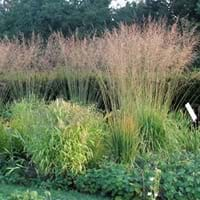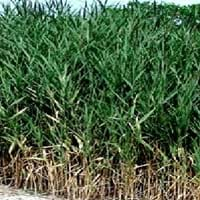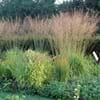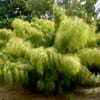Life Span
Perennial
Perennial
Origin
Europe, Eastern Europe, Southern Europe, Russia/Siberia, Asia, Central Asia, Southern Asia
Southern Europe
Types
Not Available
Arundo, Carrizo
Habitat
Boggy areas, Dry and Young forest Heaths, Lowland
Saline Soils, Sandy areas
USDA Hardiness Zone
5-8
6-10
AHS Heat Zone
9 - 1
12 - 1
Sunset Zone
1a, 1b, 2a, 2b, 3a, 3b, 4, 5, 6, 7, 8, 9, 14, 15, 16, 17
3a, 3b, 4, 5, 6, 7, 8, 9, 10, 11, 12, 13, 14, 15, 16, 17, 18, 19, 20, 21, 22, 23, 24
Habit
Arching/Fountain-shaped
Upright/Erect
Flower Color
Dark Purple
Not Available
Flower Color Modifier
Bicolor
Bicolor
Fruit Color
Non Fruiting Plant
Not Available
Leaf Color in Spring
Green
Green, Gray Green
Leaf Color in Summer
Light Green
Light Green
Leaf Color in Fall
Green, Gold
Green, Gray Green
Leaf Color in Winter
Tan
Green, Gray Green
Leaf Shape
Needle like
Linear
Plant Season
Spring, Summer, Fall, Winter
Spring, Summer, Fall, Winter
Sunlight
Partial Sun, Partial shade
Full Sun
Growth Rate
Slow
Very Fast
Type of Soil
Clay, Loam, Sand
Clay, Loam, Sand
The pH of Soil
Acidic, Neutral
Acidic, Neutral, Alkaline
Soil Drainage
Average
Average
Bloom Time
Early Summer, Summer, Late Summer, Early Fall
Late Summer, Early Fall, Fall, Late Fall
Tolerances
Not Available
Wet Site, Drought, Salt
Where to Plant?
Ground, Pot
Ground
How to Plant?
Divison, Transplanting, Vegetative Reproduction
From Rhizomes, Stem Planting
Plant Maintenance
Low
Medium
Watering Requirements
Requires regular watering, Water more frequently during periods of extreme drought
Requires a lot of watering
In Summer
Lots of watering
Lots of watering
In Spring
Moderate
Moderate
In Winter
Average Water
Average Water
Soil pH
Acidic, Neutral
Acidic, Neutral, Alkaline
Soil Type
Clay, Loam, Sand
Clay, Loam, Sand
Soil Drainage Capacity
Average
Average
Sun Exposure
Partial Sun, Partial shade
Full Sun
Pruning
Prune in winter, Remove damaged leaves, Remove dead branches, Remove dead leaves
Do not prune during shooting season, Prune after harvesting, Remove damaged leaves, Remove dead branches, Remove dead leaves
Fertilizers
No need to fertilize every year
All-Purpose Liquid Fertilizer, Fertilize in early spring
Pests and Diseases
Pests and diseases free
Not Available
Plant Tolerance
Not Available
Drought
Flower Petal Number
Single
Single
Foliage Texture
Medium
Bold
Foliage Sheen
Matte
Matte
Attracts
Not Available
Bees, Birds, Hummingbirds
Allergy
Not Available
allergic conjunctivitis, flushing of face, wheezing
Aesthetic Uses
Showy Purposes, Water gardening
Beautification, Bonsai
Beauty Benefits
Not Available
Making cosmetics, Skin cleanser
Environmental Uses
No fertilizer, pesticides, or herbicides needed
Agroforestry, Air purification, Nesting sites for birds, No fertilizer, pesticides, or herbicides needed, Prevent Soil Erosion, Shadow Tree, soil stabilisation
Medicinal Uses
No Medicinal Use
Diaphoretic, Diuretic, Emmoiliant
Part of Plant Used
Whole plant
Bark, Sap
Other Uses
Used as Ornamental plant
Basketary, Showy Purposes, Used in making musical instruments, Wood is used in construction
Used As Indoor Plant
No
Sometimes
Used As Outdoor Plant
Yes
Yes
Garden Design
Bedding Plant, Container, Cutflower, Dried Flower/Everlasting, Mixed Border
Container, Cutflower, Dried Flower/Everlasting, Feature Plant, Mixed Border, Screening / Wind Break, Tropical, Water Gardens
Botanical Name
Molinia arundinacea
ARUNDO donax
Common Name
Moor Grass
Giant Reed
In Hindi
Tall Moor Grass
नरकट
In German
Hoch Pfeifengras
Pfahlrohr
In French
Herbe Moor hauteur
Arundo donax
In Spanish
Tall Grass Moor
Arundo donax
In Greek
Ψηλός Moor Grass
Arundo donax
In Portuguese
Alto Moor Relva
Cana-do-reino
In Polish
Wysoki Moor Trawa
Lasecznica trzcinowata
In Latin
Alta Maurus Grass
Arundo donax
Phylum
Magnoliophyta
Angiosperms
Class
Liliopsida
Liliopsida
Order
Cyperales
Cyperales
Clade
Angiosperms, Commelinids, Monocots
Commelinids
Tribe
Not Available
Not Available
Subfamily
Not Available
Not Available
Number of Species
Not Available
Not Available
Importance of Molinia Arundinacea and Giant Reed
Want to have the most appropriate plant for your garden? You might want to know the importance of Molinia Arundinacea and Giant Reed. Basically, these two plants vary in many aspects. Compare Molinia Arundinacea and Giant Reed as they differ in many characteristics such as their life, care, benefits, facts, etc. Every gardener must at least have the slightest clue about the plants he wants to plant in his garden. Compare their benefits, which differ in many ways like facts and uses. The medicinal use of Molinia Arundinacea is No Medicinal Use whereas of Giant Reed is Diaphoretic, Diuretic and Emmoiliant. Molinia Arundinacea has beauty benefits as follows: Not Available while Giant Reed has beauty benefits as follows: Not Available.
Compare Facts of Molinia Arundinacea vs Giant Reed
How to choose the best garden plant for your garden depending upon its facts? Here garden plant comparison will help you to solve this query. Compare the facts of Molinia Arundinacea vs Giant Reed and know which one to choose. As garden plants have benefits and other uses, allergy is also a major drawback of plants for some people. Allergic reactions of Molinia Arundinacea are Not Available whereas of Giant Reed have allergic conjunctivitis, flushing of face and wheezing respectively. Having a fruit bearing plant in your garden can be a plus point of your garden. Molinia Arundinacea has showy fruits and Giant Reed has no showy fruits. Also Molinia Arundinacea is not flowering and Giant Reed is not flowering . You can compare Molinia Arundinacea and Giant Reed facts and facts of other plants too.





